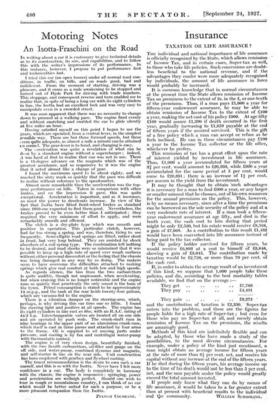Motoring Notes
An Isotta-Fraschini on the Road
IN writing about a car it is customary to give technical details as to its construction, its size, and capabilities, and to follow this with the writer's impressions of its performance. In this instance, however, I propose to put performance first and technicalities last.
I tried this car (an open tourer) under all normal road con- ditions, in traffic, on hills, and on roads good, bad and indifferent. From the moment of starting, driving was a pleasure, and it came as a rude awakening to be stopped and turned out of Hyde Park for driving with trade numbers. This stoppage, and consequent reverse and turn enabled me to realize that, in spite of being a long car with its eight cylinders in line, the Isotta had an excellent lock and was very easy to manipulate even in a crowded street.
It was soon apparent that there was no necessity to change down to proceed at a walking pace. The engine fired evenly and without snatching and enabled the car to glide silently at five miles an hour.
Having satisfied myself on this point I began to use the gears, which are operated, from a central lever, in the simplest possible way. There are but three forward speeds, but these ..eem quite adequate, as almost a mile a minute can be attained en second. The gear-lever is to hand, and changing is easy.
The acceleration was quite a revelation of what can be done by a standard engine without a supercharger ; indeed, it was hard at first to realize that one was not in use. There is a 45-degree advance on the magneto which was of the greatest assistance, and so responsive to it was the engine that it acted almost like a change of gear.
I found the maximum speed to be about eighty, and we reached the sixty mark so quickly that the pace was difficult to realize without reference to the speedometer.
Almost more remarkable than the acceleration was the top- gear performance on hills. Taken in comparison with other makes, and on the impression it gave, this was quite exCeptional. Acceleration is important, and as it increases, so- must the power to decelerate increase. In view of the fact that Isotta have fitted front-wheel brakes as standard since 1910 one expected to find them good. Nevertheless, the brakes proved to be even better than I anticipated ; they required the very minimum of effort to apply, and were remarkably smooth and efficient.
The clutch is a dry-plate type which was smooth and positive in operation. This particular clutch, however, had far too strong a spring, and was, therefore, tiring to use frequently. Semi-elliptic road springs are fitted, rather short in front, but very long behind. They are assisted by shock absorbers of a coil spring type. The combination left nothing to be desired, and road shocks were so minimized that it was possible to keep up a high rate of speed over rough surfaces without either personal discomfort or the feeling that the chassis was being damaged in any way by so doing. The makers seem to have overcome the difficulties attached to making springs which give real comfort at both low and high speeds.
As regards silence, the hiss from the two carburettors is quite audible, though not unpleasant, when accelerating, but when cruising this is no longer noticeable and the engine runs so quietly that practically the only sound is the hum of the tyres. Petrol consumption is stated to be approximately 14 m.p.g., and the tank at the rear holds twenty-four gallons, which are vacuum-fed to the engine.
There is a vibration damper on the steering-arm, which, perhaps, is why driving this car tires one so little. I found the steering light and positive at all speeds. The engine has its.eight cylinders in line cast en bloc, with an R.A.C. rating of 44.,3 h.p. Interchangeable valves are located all on one side and are operated by push rods. The crank-shaft runs in nine bearings in the upper part of an aluminium crank-case, which itself is cast in three pieces and attached by four arms to the frame. Oil is supplied to all moving parts under pressure, and cooling is by fan and centrifugal water-pump with thermostatic control.
The engine is of very clean design, beautifully finished, with the two Zenith carburettors, oil-filler and gauge on the off side, and water-pump, combined dynamo and magneto, and self-starter in line on the near side. Unit construction has been employed with gearbox and flywheel casting.
The truest recommendation is the desire to own such a car oneself, and this is so with the Isotta. Never have I felt more confidence in a car. The body is completely in harmony with the chassis, the engine is responsive ; 'springing, power and acceleration are wellnigh perfect. Should one wish to tour in rough or mountainous country,t can think of no car which would be better suited for such a purpose, or be a more pleasant companion than the Isotta.
PELnAm COCHRANE.










































 Previous page
Previous page